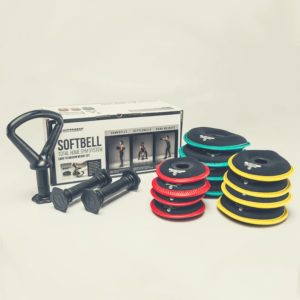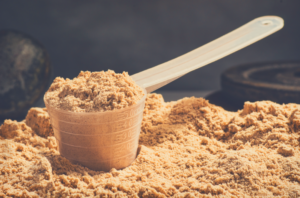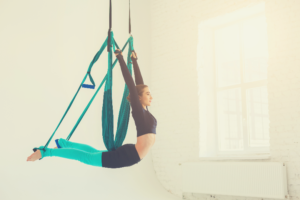Perhaps you have joint problems. Or maybe you’re significantly overweight. Possibly you just really dislike jumping, running.
Whatever your reason, including cardio that’s low-impact into your routine, has a wide array of benefits.
What is Considered Low-Impact Cardio?
More often than not, people confuse low-impact with low-intensity.
However, in its purest form, low-impact cardio is anything that increases your heart rate while reducing the impact on your joints.
It’s the opposite of high-impact cardio like running, box jumps, burpees, and jumping, which is what we commonly associate with cardio.
The problem with high-impact workouts is that because you’re putting so much extra stress on your joints, you’re at greater risk of injury.
Take a box jump, for example; as you land, the jarring impact of your entire body weight courses through your joints. Even a slight wobble can cause an acute injury.
Low impact workouts, on the other hand, removes that stress. Generally speaking, anything where you are seated or have at least one foot on the ground, is considered low impact.
What then separates lifting or strength training from this type of cardio?
Your heart rate and how your body is able to use oxygen are two critical pieces of what separates a cardio workout from other types of exercise.
Ideally, for a cardio workout, you’d like your heart rate to be anywhere between a moderate and vigorous intensity.
These zones are calculated as a percentage of your maximum heart rate where a moderate intensity would be in the range of 64%-76%, and vigorous intensity would be 77%-95% of your max.
While a fitness wearable is the most common way of determining where your heart rate lies within the target heart rate zones, it’s not a necessity.
One way to gauge your intensity is to use what’s called the rate of perceived exertion, or RPE.
On an RPE scale, a one would be comparable to walking around the house, doing the dishes, or very light activity.
A ten on the RPE scale would be the absolute hardest you could push, and you’d only be able to accomplish that activity for seconds at a time.
For a non-athlete, this may be a 15-20 second sprint. If cardio is your goal, you’ll want to aim for a six to an eight on the RPE scale.
What Are the Benefits of Low-Impact Cardio?
If you’re wondering what the benefits of low impact cardio are, here are just a few:
Manage and Prevent Disease
Cardiorespiratory fitness, which is your body’s ability to supply oxygen throughout your body during exercise, is another component of a cardio workout.
Increasing your cardiorespiratory fitness isn’t just a benchmark of cardio workouts.
According to the American Heart Association, increasing the maximum oxygen consumption rate has been shown to reduce hospitalizations and mortality of those with heart failure by 28%-35%.
In addition to its heart-healthy benefits, cardio workouts can help you manage and prevent things like type 2 diabetes and high blood pressure, and cholesterol.
It’s Available to Everyone
As mentioned earlier, low-impact workouts by their very name, reduce the impact on your joints which directly impacts the likelihood of injury and keeps your joints healthy as you get older.
This gives people with chronic joint problems, older adults, and those who are significantly overweight a safe option to reap the benefits of a cardio workout.
People recovering from injuries can also incorporate low-impact cardio into their workout regime, of course with a doctor’s approval.
Even if you’re generally healthy, the more high-impact workouts you put your body through, the higher the wear and tear.
Minimize Recovery Time
When you put your body through a high-impact workout, it’s necessary to give the body time to recover.
Additionally, these types of exercises tend to be quick and dirty, as your body can only handle so much at a time.
On the other hand, you can work out longer and require less recovery time between sessions by choosing low-impact cardio. Less recovery time often means more consistency.
Of course, this doesn’t mean high-impact workouts are bad. In fact, adding in low-impact sessions on your rest days will help you improve your performance in high-impact workouts and strength training and increase blood flow which can help sore areas recover quicker.
Build Muscle and Burn Calories
Working out for more extended periods will increase your endurance and allow you to build muscle without the risk of hurting your joints, ligaments, and tendons.
The number of calories you torch is based on your intensity, not your impact, so choosing a low-impact option isn’t going to blow your chances of weight loss.
Some studies have found that low-impact workouts are just as effective as their high-impact siblings.
Additionally, many low-impact workouts get your whole body moving, and the more muscles you activate with each movement, the higher the calorie burn.
It Can Improve Your Mobility
A lot of low-impact workouts get your body moving in all directions. This increased range of motion helps your body move better.
Getting your body moving laterally, for example, in a cardio dance class, will also help to strengthen the muscles around your joints.
This aids in injury prevention but also helps to protect and stabilize the joints.
It’s a Stress Buster
Cardio workouts release endorphins, a chemical that your nervous system produces to help with pain and stress.
You can think of it like your body’s natural pain killer, and in fact, endorphins have been compared to opioid medication like morphine.
It’s so effective in boosting moods that it has become commonplace to “prescribe” exercise for mental health disorders like depression and bipolar disorders, and even substance abuse.

What Are Some Examples of Low-Impact Cardio?
There’s not a lack of variety when it comes to low-impact heart-pumping workouts.
Seated Exercise Equipment
Whether you head to the trails on your bike, head to a spin class, row, or spend some time on a recumbent trainer, seated cardio can lead to an excellent low-impact sweat session.
These workouts hit your core muscles, legs and you can easily add in some upper bodywork. If you’re choosing an indoor piece of equipment, you can easily scale your workout up or down by adjusting your resistance settings and pace.
If you’re headed to the great outdoors, consider getting the best bang for your buck by commuting to and from work on your bike.
Ellipticals
This mainstay piece of gym equipment has found its way into many home gyms due to its full-body cardio benefits.
Most models let you move forward or backward, which puts you in the driver seat depending on what muscles you want to focus on.
The built-in workouts take a lot of the guesswork out of your training and, as it mimics the movement of running, is an excellent alternative to a treadmill.
Swimming
If you’re not convinced that swimming is a cardio workout, take a look at Michael Phelps.
Swimming requires your entire body to activate and work together to push against the resistance of the water.
At the same time, the water holds your body up, reducing the stress on your joints while increasing your heart rate.
Yoga
While many think of yoga as a static, strength-focused workout, certain styles of yoga, like vinyasa flows, move through positions quite quickly, which can increase your heart rate to cardio zones.
Cardio Dance
Dancing is a fun-filled path to cardio zones. Of course, certain types of dance, like traditional ballet and jazz classes, aren’t strictly low impact, as they involve leaps and jumps.
However, classes like Zumba, salsa classes, jazzercise, and hip-hop cardio classes typically don’t require any type of high-impact movements.
Walking
Walking and power walking are amongst our favorites for a low-impact, moderate-intensity workout.
By increasing your pace, adding incline, and moving your arms, you can activate your whole body and get the heart really pumping.
The best part is that you can literally do it anywhere, even if you’re just doing laps around your house.
How Many Calories Does Low-Impact Cardio Burn?
How many calories you burn during a workout greatly depends on your body. A larger person will burn more calories than a smaller person simply because it requires more effort to move a larger mass.
Your heart rate, intensity, and several other factors also contribute to your calorie burn.
For example, a 125-pound person can burn approximately 210 calories in a 30-minute moderate rowing session, while a 185-pound person can burn 294 calories at the same intensity for the same amount of time.
If you bump up the intensity to a vigorous session, the 125-pound person can burn 255 calories compared to the 440 calories burned by the 185-pound person.
Generally speaking, something like water aerobics will be on the lower end of the caloric burn, while indoor cycling is on the higher end.
Calculating calorie burn for your specific case can be complex. There are, however, online calculators, along with apps like My Fitness Pal, that can do the math for you.
Of course, fitness wearables are another option to calculate calories burned. The accuracy of fitness wearables really depends on the brand and features.
Wearables with heart rate monitors will provide a more accurate count.

How Often Can I Do Low-Impact Cardio?
Because you’re reducing the stress and wear and tear on your body, you can increase the frequency of lower-impact cardio workouts.
This increased frequency will help you remain consistent, and if you’re not sure you believe us, think back to the last time you stopped working out.
Did it happen gradually? One skipped workout here, another there until your rest days outnumbered your workout days?
So, how often is too often? Well, that depends on you. The gold standard of recommendations is 150 minutes of moderate aerobic activity per week.
You can break this down however you like, but for this type of cardio to really be effective, you’ll want to go with at least 30-60 minutes per day.
Some professionals will suggest a couple of micro-workouts a day, for example, a 15-minute brisk walk three times a day.
Others suggest doing all 30-60 minutes in one session. What’s best for you will be what you are capable and motivated to do.
The one piece of the puzzle you can’t ignore is your body. You may find that you’re incredibly sore the day after a particularly intense dance class or too many laps at the pool.
Listen to your body; if you’re sore, take a rest day and get back on the horse the following day.
The last thing you want to do is cause an injury or overtrain. So, while you can safely do lower-impact workouts more frequently than its high-impact counterparts, it is possible to do too much cardio.
Best Low-Impact Cardio Machines
| Hydrow Rower | Teeter FreeStep LT3 Recumbent Cross Trainer | Cubii JR1 Seated Under Desk Elliptical Machine |
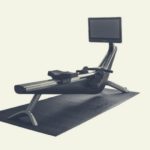 |
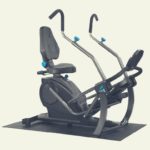 |
 |
| The Hydrow Rower is a premium rowing machine that made it on our list because we are just floored with the quality of this rower. | The Teeter FreeStep LT3 Recumbent Cross Trainer is the best option on the market we could find for an affordable low impact machine that puts minimum stress on your knees and joints. | The Cubii JR1 Seated Under Desk Elliptical Machine is made for those who are really limited in their physical activity but still want to do some cardio exercises while seated. |
 |
 |
 |
Final Thoughts
While low-impact cardio is a much safer alternative to high-impact workouts, that doesn’t mean that you can sacrifice the safety foundations of training.
Remember always to warm up and cool down. It’s important to stretch after a workout as that will help to prevent something called delayed onset muscle soreness.
If you have any underlying conditions, you should always talk with your doctor before performing any type of exercise.
This includes physical limitations like injuries, obesity, arthritis, and other joint issues, as well as systemic diseases like cancer, postural orthostatic tachycardia syndrome, and heart disease.
Older adults should also check with their doctor before trying a new type of workout. As we age, priorities change along with our bodies, so it’s crucial to select workouts best suited to your mobility.
If you’re a senior on the hunt for a low-impact exercise machine, take a look at our article on the Best Exercise Equipment for Seniors.

